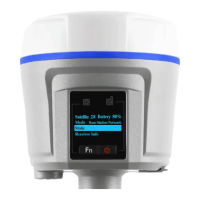49
2. After point calibration, users can start measuring directly.
3. Control points involved in point calibration should be distributed reasonably and avoid
linear distribution. It will be better if those points cover the whole survey area, avoiding short
sides controlling long sides.
6.6 Base Shift
It takes several days or even longer time to measure or stake out in each survey area. In
order to avoid repeated point calibration or troublesomely erecting the base on the same
known point everyday, users can do Base Shift before starting surveying everyday( at this
point, the base can be erected at random or set to Auto Base, but the rover’s operation is a
process that is finding a measured point and moving to that).
The specific explanation is shown as follows:
After users erect bases repeatedly, the software will orderly name the bases Base 1, Base
2,Base 3 and so on
The rover’s coordinates are based on the base’s original coordinates which will change as a
result of moving the base, so users need to reset local coordinates every time moving the
base.
Open LandStar6, in the main menu, click [Survey]→[Base Shift] to enter Base Shift
interface. It is necessary to shift base when the base moves or needs restarting because of
erecting on an unknown point. Users need to find a known point and measure its
coordinates to calculate the shift data. Then apply the shift data and make it function on all
survey points in current coordinate system. Make sure the two bases’ coordinates have the
same reference coordinate system.
Enter Base Shift interface, select known points from [Known Point] Library, click [GNSS
Point] Library to select the same point surveyed just now. The software will calculate the

